Ho Chi Minh City is the largest metropolis in Vietnam. It is made up of 24 districts ranging from vibrant urban centers to peaceful suburban areas, all full of life and modern bustling streets. Each district has its unique charm that invites visitors to explore every corner. The city attracts around 30 million tourists yearly, yet many find themselves overwhelmed by the vast number of districts spread across a network of streets.
That’s why a guide to Ho Chi Minh city districts will be your ideal companion when visiting this dynamic city. This guide covers everything from famous downtown areas to new urban developments and quiet suburban escapes. Whether you’re drawn to the city’s energetic vibe or prefer a more relaxed atmosphere, you’ll be able to fully experience the beauty of this lively and ever-growing destination.
Overview of the History and Guide to Ho Chi Minh City Districts
Guide to Ho Chi Minh City Districts
Ho Chi Minh City is deeply intertwined with many pivotal moments in Vietnam’s history. From its beginnings as a small trading port in the 17th century, the city transformed into a bustling international commercial center under French colonial rule, then known as Saigon. Later, it fell under the control of the U.S.-backed puppet regime of the Republic of Vietnam until it was completely liberated in 1975, following a heroic battle that unified the nation. After independence, the government merged Saigon with Gia Dinh Province and renamed it Ho Chi Minh City, a name that has endured to this day.
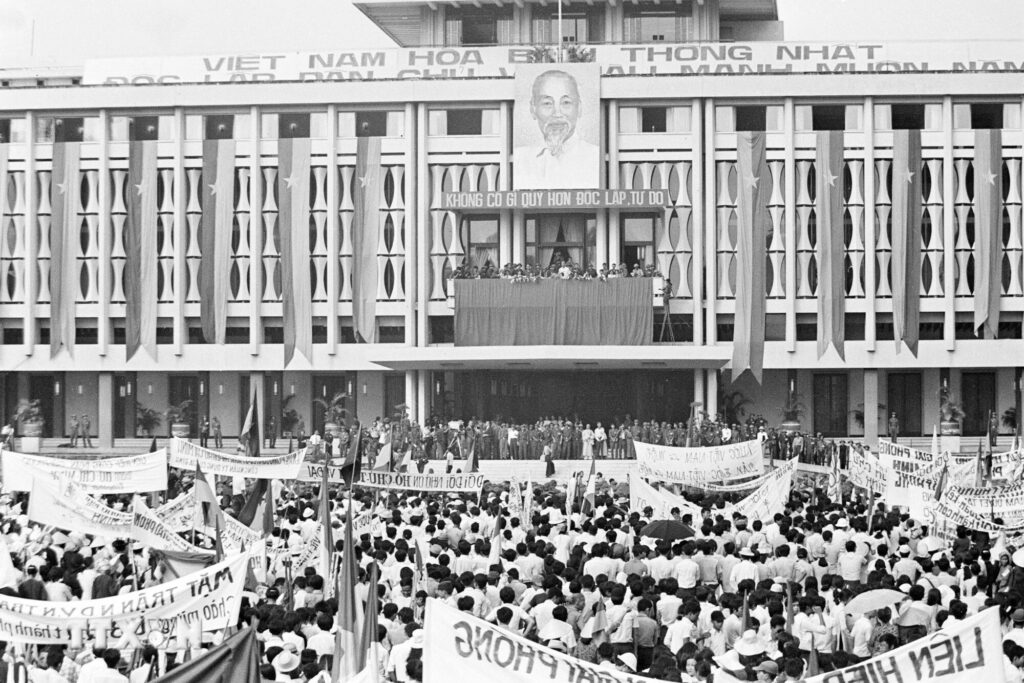
Initially, Ho Chi Minh City only had 5 districts (District 1, District 3, District 4, District 5) and 1 suburban district (Nha Be District), but over time, many districts and suburban areas were split and upgraded to accommodate the growing population and more people migrated to the city. Today, Ho Chi Minh City has a total of 19 districts and 5 suburban districts, including:
- 19 urban districts: District 1, District 2, District 3, District 4, District 5, District 6, District 7, District 8, District 9, District 10, District 11, District 12, Binh Thanh, Tan Binh, Tan Phu, Go Vap, Phu Nhuan, Binh Tan, and Thu Duc City (a city within Ho Chi Minh City).
- 5 suburban districts: Nha Be District, Cu Chi District, Can Gio District, Binh Chanh District, and Hoc Mon District.
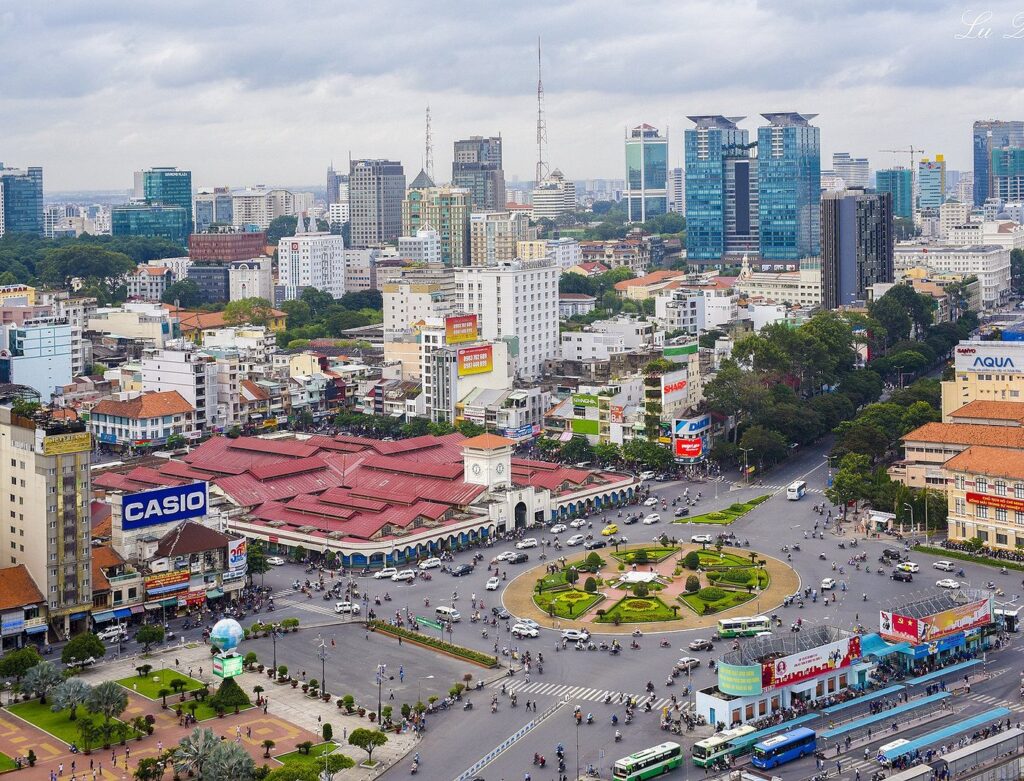
Each district in Ho Chi Minh City has its diverse cultural characteristics and lifestyle. The streets here are named after geographical regions or historical figures who made significant contributions to the country’s revolution, such as Nguyen Hue Street, Le Duan Street, Vo Nguyen Giap Street, Vo Van Kiet Street, and Hoang Sa – Truong Sa Streets (named after two archipelagos under Vietnam’s sovereignty), among others. These streets are not merely names but stand as symbols of honoring history and the contributions of previous generations in building and defending the nation. The name Ho Chi Minh City itself is a tribute to President Ho Chi Minh, Vietnam’s revered leader.
Guide to Ho Chi Minh City Districts Map
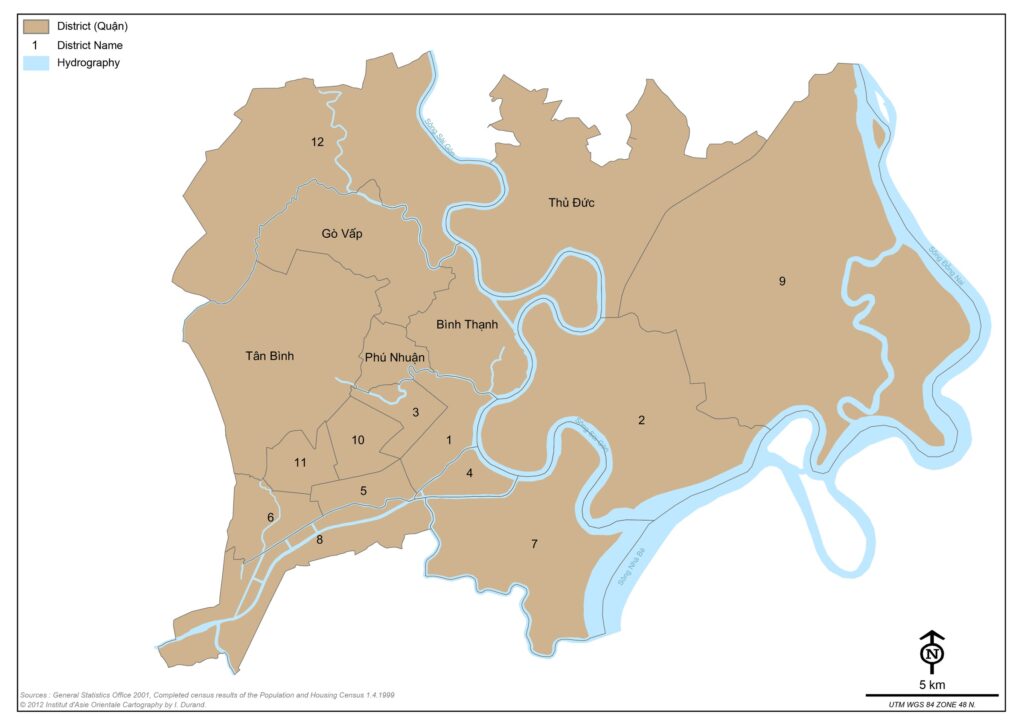
Ho Chi Minh City is home to 24 districts with over 9 million Vietnamese residents. Looking at a map of Ho Chi Minh City’s districts, you’ll notice that the districts encircle District 1, which is the city’s central hub, bustling with commercial areas and major entertainment venues.
The Saigon River flows through several districts, including Binh Thanh, District 1, District 4, and District 7. As you visit these areas, you’ll discover beautiful spots along the river, lined with parks and piers (like the Saigon Water Bus in District 1). Blessed with natural beauty, Ho Chi Minh City has become one of the most desirable places to live and visit in Vietnam.
Are you looking for a guide to Ho Chi Minh City districts? Now, let’s follow Jackfruit as we embark on a journey to explore the exciting features of each district in Ho Chi Minh City. This will surely be the most detailed guide to Ho Chi Minh City’s districts you’ll ever find. (By the way, if you’re ready to come to Vietnam, check out our guide on how to get a Vietnam visa.)
Discover a Detailed Guide to the Central Districts of Ho Chi Minh City
Guide to Ho Chi Minh City Districts
When thinking about the central districts of Ho Chi Minh City, District 1 is probably the first that comes to mind, right? That’s right, District 1 isn’t just a bustling downtown area, it’s where history blends seamlessly with modern life in every corner, and where many famous architectural landmarks are located. But beyond District 1, the nearby central districts also have their unique charm and captivating stories that are just waiting to be explored. In this section, I’ll introduce you to the central districts that attract the most visitors. So, keep reading to uncover everything you need to know about the districts of Ho Chi Minh City!

District 1: The Heart of the City
Guide to Ho Chi Minh City Districts
If Ho Chi Minh City is the economic center of Vietnam, then District 1 is undoubtedly its heart. Established in the 1960s, District 1 has always been a crucial hub for the city’s economy, politics, and culture, home to iconic skyscrapers and historic landmarks that are hundreds of years old, such as Ben Thanh Market, Notre-Dame Cathedral, Central Post Office, Independence Palace, Saigon Opera House, and Rex Hotel.
When you visit District 1, you’ll find everything you could possibly want, from shopping malls and historical sites to dining options that range from casual to upscale. Imagine starting your morning with breakfast at Ben Thanh Market, visiting the Central Post Office, strolling along Book Street, enjoying lunch with a variety of choices like pho, banh mi, and com tam, shopping at Vincom Center, relaxing with a water bus ride in the afternoon, and capping off your day by taking in the views along the Saigon River before experiencing the nightlife on Bui Vien Street. This will definitely be quite an exciting experience in a guide to Ho Chi Minh City districts.

Moreover, District 1 is conveniently located in the center of the city so making it easy to travel to other districts. You can reach neighboring District 3 in just 2 km, glide through to District 4 in about 3 km, and if you wish to visit the vibrant Chinatown in District 5 or enjoy a walk and admire landmarks in Binh Thanh District, it’s only about 4 km away. These districts are all close to District 1, and you can easily get around by motorbike (if you have a license), bicycle, or by using ride-hailing apps like Grab, Be, or Xanh SM.
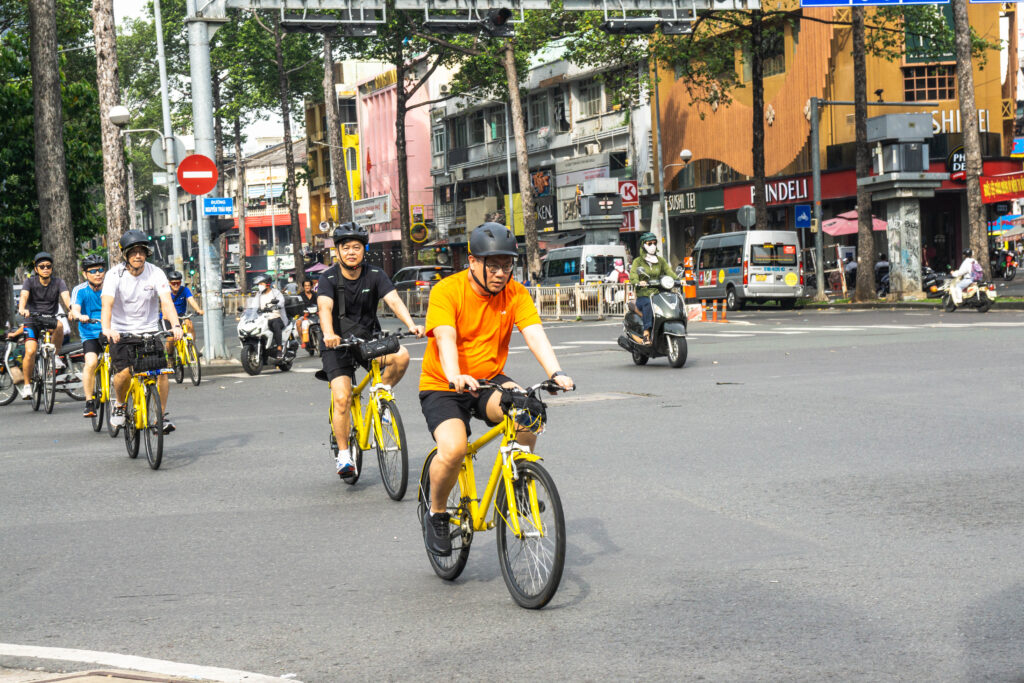
District 2: The Expanding Urban Hub
Guide to Ho Chi Minh City Districts
Previously, District 2 was part of Thu Duc District, primarily consisting of rural areas filled with rice fields and orchards, and it received little attention in Ho Chi Minh City’s urban development. However, after District 2 was separated from Thu Duc, it began to attract significant investment from the city government to develop the new urban area of Thủ Thiêm, marking a rapid transformation and continuous milestones for the region. Over time, shopping centers and residential complexes were established, and District 2 started to thrive, integrating into the city’s wave of development.
With the strong growth of infrastructure and amenities, the population in District 2 surged. In addition to local residents, it has become home to many expatriates, thanks to the presence of numerous international schools and English language centers. Coupled with its tranquil atmosphere, District 2 is an ideal place for foreigners to settle and work in Vietnam.
When you follow a guide to Ho Chi Minh City districts, you can explore notable areas in District 2, such as Thảo Điền, known for its luxurious villas, restaurants, and upscale cafés. An Phu is filled with shopping centers, supermarkets, and high-end apartment projects, while Thu Thiem boasts large urban developments and entertainment facilities. District 2 is conveniently located next to District 1, just 7 km away via the Thu Thiem Bridge or the Saigon Bridge and you can make it easy to access District 3 similarly. If you want to reach District 4, you can cross the Khánh Hội or Calmette Bridges, which takes only 15 to 20 minutes.

To avoid confusion, in 2021, District 2 and District 9 were merged into Thủ Đức City which is now part of Ho Chi Minh City. Nowadays, District 2 is only used to refer to Area 1 of Thu Duc City. Therefore, when you search for locations on the Ho Chi Minh City District Map, you will see some addresses showing Thu Duc instead of District 2.
Suggestions for destinations, restaurants, and cafes:
- Destinations: E-mart Sala, Vincom Mega Mall Thao Dien, Family Garden 2, Ham Thu Thiem Park.
- Restaurants: MFTT Saigon, Fries Fries Saigon, Sushi Nhi, Baba’s Kitchen.
- Cafes: Bonjour Cafe The Art, Rang Rang Coffee, Dalaland Coffee.
District 3: Cultural Hub
Guide to Ho Chi Minh City Districts
District 3 is always mentioned as a twin brother of District 1 because they were born and grew up together from the colonial period until now. Despite its small area (only about 5 km), District 3 has always maintained its position as the center and administrative district of the city. Along the streets of Vo Van Tan, Pasteur, Nam Ky Khoi Nghia, and Le Quy Don, there are many shady green trees, so there are many parks, restaurants, and cafes here. Although it is a central district, the pace of life in District 3 is not too hectic. When you come here, you can see many people leisurely walking in the park or sitting and enjoying coffee on the sidewalk.

Like District 1, District 3 is also a place with many famous historical sites such as the War Remnants Museum, Nguyen Thien Thuat apartment building, Phap Hoa Pagoda, Vinh Nghiem Pagoda, Tan Dinh Church (pink church), and Turtle Lake.
If you pass by Turtle Lake, you will be surprised to see a lake located right in the middle of the intersection with a large column inside the lake. This is not a coincidence. There is a legend that in the past, the former President of the Republic of Vietnam, Nguyen Van Thieu, invited a feng shui master to see the dragon vein for the Independence Palace. He said that the position of the palace was built on the dragon’s head, but the dragon’s tail was located in the Soldier’s Square (later renamed International Square), which is a turbulent area that could affect the career. Therefore, it was necessary to stabilize and maintain the position of the current president.
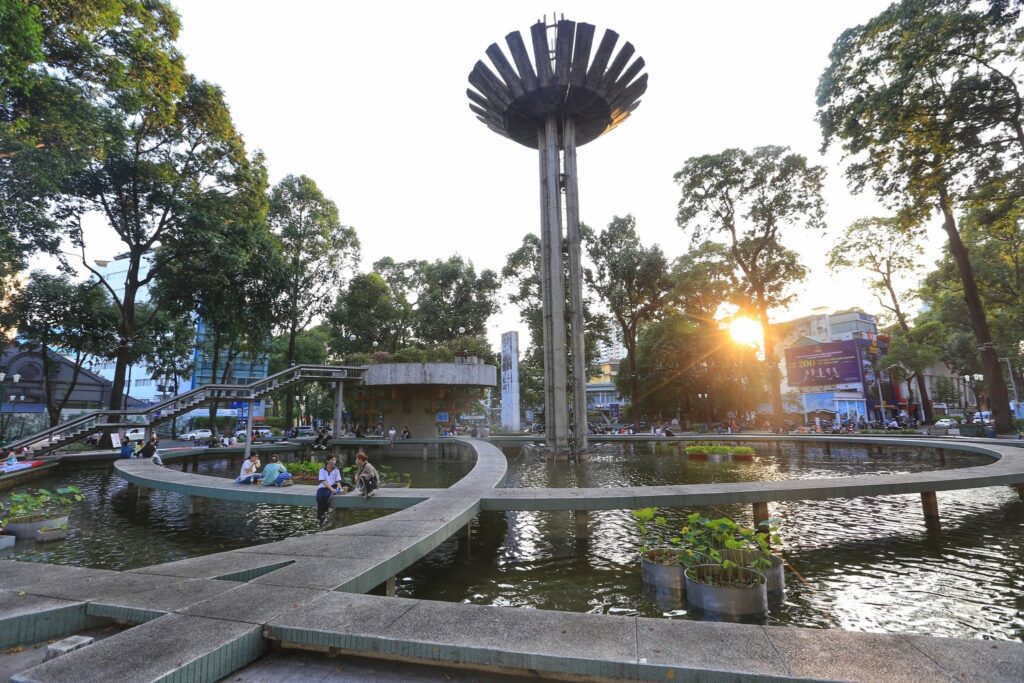
Being a believer in feng shui, Nguyen Van Thieu immediately ordered the construction of a water lake in the shape of a yin-yang symbol, cast a large bronze turtle, and erected a tall tower resembling a sword thrust into the lake to block the dragon’s tail. Since then, people have been calling it Turtle Lake instead of its official name. Although the turtle statue was later destroyed in an explosion, the locals still affectionately call it Turtle Lake as a familiar “nickname”.

Read more: Vietnamese Culture – 24 Traditions You Should Know
District 4: The Riverside Gem
Guide to Ho Chi Minh City Districts
The reason it is called the riverside gem is because in the past, District 4 was considered a place closely associated with the seaport and was a complex area in terms of security. But since the early 2000s, District 4 has gradually changed its appearance and become an ideal living place for many young residents. When you come to District 4, you can freely explore traditional markets, bustling street food areas, restaurants, eateries, and night markets. That’s why District 4 is always known as the “food paradise” with a variety of dishes from seafood to traditional foods. Especially when you stroll through the alleys, experiencing Saigon’s off-the-beaten-path hidden stories, you will surely have unforgettable memories.

In addition to its culinary fame, District 4 is also famous for the landmark of Ben Nghe River Port – a place that used to play an important role in the maritime economic strategy due to its location adjacent to the Saigon River, convenient for the development of seaports and serving international trade activities.
This is also where President Ho Chi Minh departed to seek ways to save the country, embarking on a journey through many countries, enduring hardships just to find a path to independence for the Vietnamese people. To this day, Ben Nghe River Port has been rebuilt and transformed into the Ho Chi Minh Museum, a place that preserves documents, and artifacts related to the life and career of the President.

From the location of Ben Nghe River Port, you can conveniently move to other famous landmarks in District 1 such as Ben Thanh Market, Independence Palace, or Notre-Dame Cathedral. With the development and construction of bridges across the river, you can easily move to neighboring districts such as District 1 via Khanh Hoi Bridge, to Binh Thanh District via Thu Thiem Bridge, and to District 8 via Nguyen Van Cu Bridge.
Read more: Explore the Hidden Gems of District 4: A Guide to Saigon’s Secret Alleys
District 5: Chinatown (Cho Lon)
Guide to Ho Chi Minh City Districts
To talk about District 5 is a long story, this is a quite special district in a guide to Ho Chi Minh City. The story begins in the 17th century when the Minh dynasty of China collapsed, many Chinese people migrated to the southern land (now Ho Chi Minh City) to settle down and make a living. With a long-standing business tradition, they established markets, and trading streets to trade goods. Gradually, this area developed into the economic center of Saigon and quickly controlled most of the economy. Famous markets of that time include Kim Bien market, An Dong market, and Binh Tay market – which is also the largest market owned by the wealthy Quach Dam.

After the country was reunified in 1975, the economy and influence of the Chinese community had spread too widely and were difficult to control, which would lead to economic dependence and many other consequences. Recognizing the issue, the former General Secretary Le Duan issued a policy requiring Chinese people to register for citizenship and residency papers while nationalizing land and property. This caused a backlash among the Chinese community and they decided to migrate elsewhere to live. As a result, the Chinese community in Saigon significantly decreased and mainly concentrated in District 5, also known as Chinatown.

Due to its long-standing formation, Chinatown in District 5 always carries a strong Chinese cultural identity, you will not find it difficult to see shops, restaurants with Chinese signage, or streets adorned with lanterns and traditional architectural temples like Ba Thien Hau Pagoda, which is a very sacred and famous temple in Chinatown.
When you learn about the architecture of this temple, you will see that the arrangement and position of each brick, each statue here all have special meanings. If you want to find a new space in the heart of Saigon, do not miss Chinatown, you can start your journey along Quach Dam’s trails Cho Lon Saigon discovery, and finally the enchantment of Binh Tay Market.
Don’t Miss Out! Your Free 1-Page Guide to Top 20 things to do HCMC at Night
A quick, mobile-friendly guide with local-approved spots and direct links—just tap and go! No fluff, just easy night-time fun. Subscribe to download.
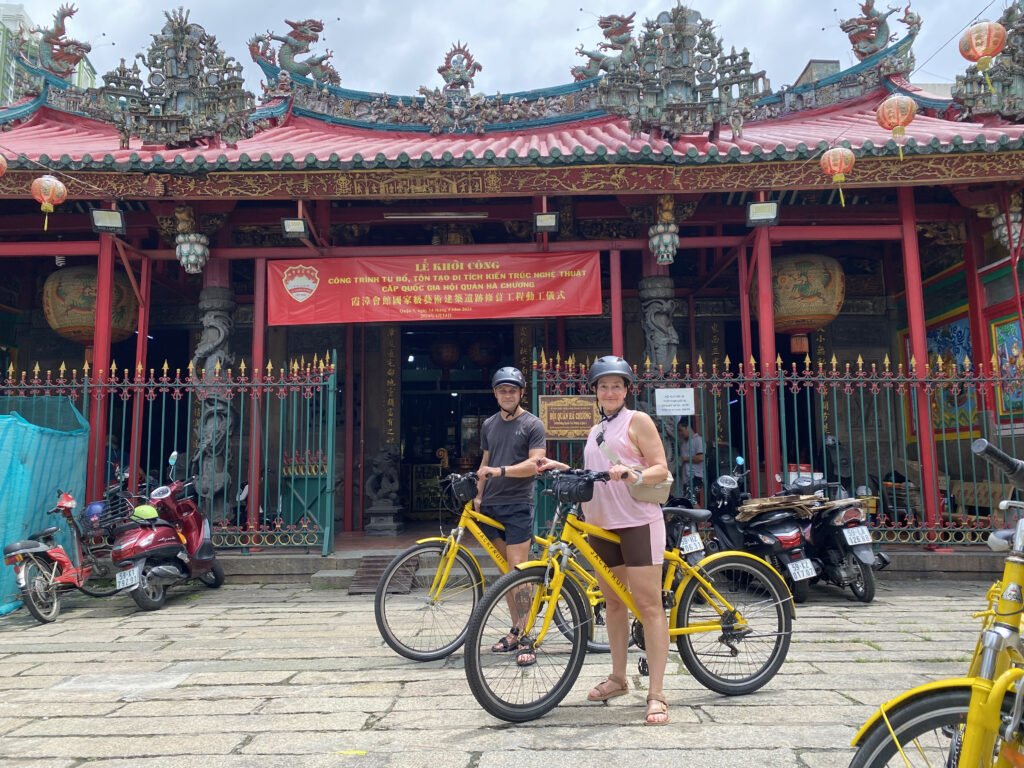
District 7: Modern Living
Guide to Ho Chi Minh City Districts
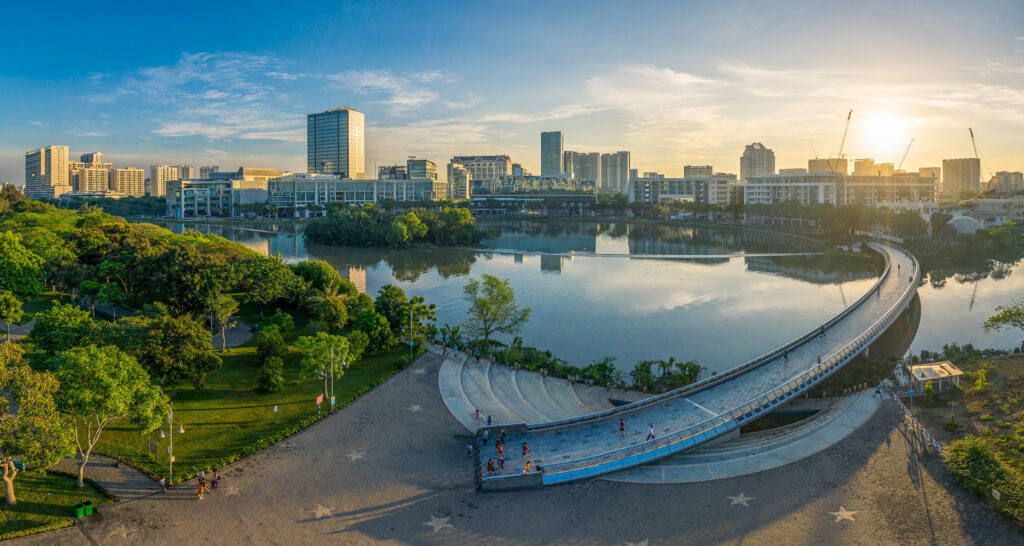
People often discuss with each other about which place in Ho Chi Minh City is the most livable, and the majority of the results are District 7. Going back over 30 years, District 7 was just a swampy and desolate land located in Nha Be district. But after being separated and formed, thanks to its rich ecosystem, District 7 quickly attracted investors to develop infrastructure, typical of the Phu My Hung urban area project. After implementation, the project not only transformed agricultural land into a modern city but also served as a foundation for comprehensive economic development.
More than just a residential area, here there are also commercial centers, international schools, hospital systems, and many amusement parks, all of which are high-end services. Therefore, the majority of the population here belongs to the high-income class, including businessmen, the Vietnamese upper class, and the foreign community.
In addition, District 7 is a special district surrounded on many sides by rivers such as Dong Nai River, Saigon River, Nha Be River, and Te Canal. Therefore, when looking down from above, this place is likened to a peaceful little island in the bustling heart of Ho Chi Minh City. Famous tourist destinations here that you can explore include Crescent Lake Park, Starlight Bridge, Lotus Gallery – Art Gallery, and Jump Arena.
District 10: Local Vibes
Guide to Ho Chi Minh City Districts
True to its title, District 10 exudes local vibes because in the past, due to wars and frequent natural disasters, the majority of the population consisted of laborers from all over the country who converged here to establish their careers, settle down, and together build their second homeland. When walking along the streets of District 10, you can see roads named after heroes such as Ly Thuong Kiet, Ngo Gia Tu, Nguyen Chi Thanh, and roads named after significant events such as Cach Mang Thang Tam Road and 3/2 Road.
District 10 is also famous for its shopping areas, local food markets, and old apartments. If you want to experience living in a place like a true Saigonese, then District 10 is the place to be. District 10 is also quite close to the city center as it borders District 3 to the east, District 11 to the west, District 5 to the south, and Tan Binh District to the north.

Binh Thanh District: Urban Diversity
Guide to Ho Chi Minh City Districts
When you arrive in Binh Thanh, you will be overwhelmed by the bustling streets, the pace of life here is quite fast, and almost all vehicles are crowded day and night. This is also understandable because Binh Thanh has always captivated tourists with the famous Landmark 81, the tallest building in Vietnam.
Besides this famous landmark, do you know what else is special here? On the land of Binh Thanh, there is a small island called Thanh Da, which is beautiful with extremely poetic natural scenery nestled by the Saigon River. Who would believe that in such a bustling Binh Thanh, there is such a peaceful place like this? This place is also considered a precious gem hidden within the splendid Saigon that you must explore.
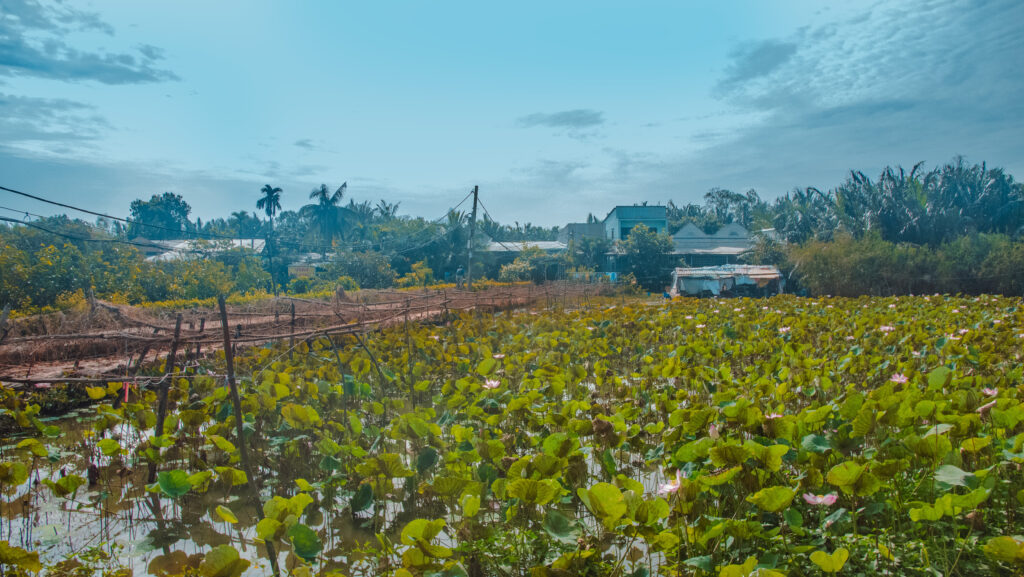
There are many ways to explore this island, you can move around by bicycle to both enjoy the cool feeling and immerse yourself in the slow pace of life here. When you set foot here, you will be surrounded by cool green trees, listen to the rustling wind, and savor the rustic cuisine here.
Imagine that one day you start exploring Thanh Da and enter an old market to buy fresh food, then go to the lake to pick lotus flowers, rest and drink coconut water, and enjoy a meal at a local house. I’m sure you will find it hard to forget these experiences! If you want to find a place to add more colors to your trip, don’t hesitate to experience the feeling on the small Thanh Da Island.

Go Vap District
Guide to Ho Chi Minh City Districts
Go Vap is a bustling and lively district due to its high population density. During the day, you can see people busy going to school and working on Pham Van Dong Street, and at night, it is just as lively but for leisure activities and stress relief after a tiring day. As the night falls, Go Vap becomes even more vibrant with the presence of numerous bars, pubs, and lounges lining Phan Van Tri Street.
In addition to the abundance of entertainment activities, Go Vap is also convenient in terms of transportation. Although the streets are often crowded, traffic jams rarely occur for hours. You can also easily travel to Tan Son Nhat Airport in Tan Binh, which is relatively close (about 3 – 5 km).
In Go Vap, besides the lively bars, you can also go shopping and visit places like Emart Phan Van Tri, Lang Hoa Park, Hanh Thong Tay Market, and Du Mien Garden Cafe.
Read more: A Complete Guide to Cycling in Vietnam
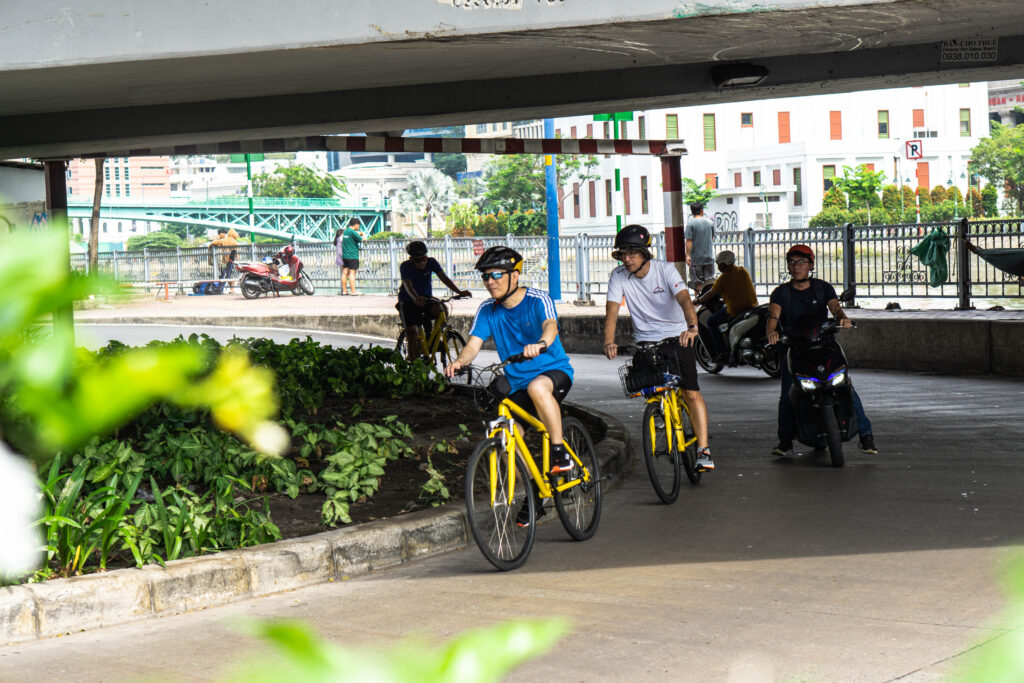
Phu Nhuan District: Charming Community
Guide to Ho Chi Minh City Districts
Phu Nhuan is considered one of the bustling central districts of Ho Chi Minh City. It is located between District 1, District 3, Tan Binh District, and Go Vap District. Phu Nhuan has a major culinary street, Phan Xich Long, where you can find a variety of Vietnamese street food, as well as Korean, Japanese, Thai, and Western cuisines.
If you happen to be hungry and find yourself on this street, you will forget about your hunger because you will be overwhelmed with food choices. There are various food stalls selling pho, bun dau mam tom, hotpot, grilled dishes, banh mi, mixed rice paper, bubble tea, and more. This is an ideal place in a guide to Ho Chi Minh City districts for you to explore the diverse culinary culture of Vietnam.
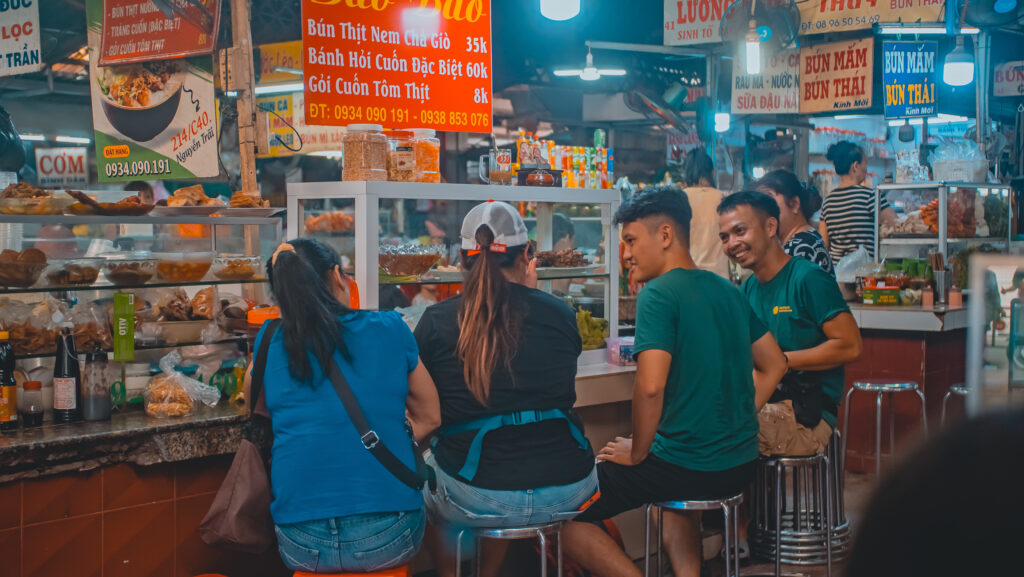
Thu Duc City: Emerging Area
Guide to Ho Chi Minh City Districts
In 2021, Thu Duc City was officially established by merging three districts: Thu Duc, District 2, and District 9, becoming a separate city under the administration of Ho Chi Minh City. Thu Duc City borders Binh Duong, Dong Nai, and Binh Thanh provinces, making it quieter and more peaceful than the central districts of the city.
With its development orientation as a smart urban area with high-tech zones and modern transportation systems, Thu Duc City is currently home to many factories, large technology companies such as Samsung, Intel, universities, research institutes, and most recently, Metro Line 1 from Ben Thanh to Suoi Tien, which is being planned for testing and expected to be operational soon.
In addition to experiencing the fresh air of Thu Duc City, you can also visit places like Buu Long Pagoda, have fun at Suoi Tien Park, and go shopping and dining at Vincom Mega Mall.

Read more: 21 Best Things to Do in Ho Chi Minh City
Guide to Suburban Districts in Ho Chi Minh City
In a guide to Ho Chi Minh City Districts, if Ho Chi Minh City is a painting, then the suburban districts are the dot strokes that make the painting more distinctive. It would be incomplete if this guide to Ho Chi Minh City districts does not include these prominent suburban districts. You will be surprised that these places are just as interesting as the city center.
Cu Chi District
Guide to Ho Chi Minh City Districts
About 30 km away from the city center, entering the Cu Chi land, you will witness a combat system that will make you exclaim, “How can this exist?”. Not unfamiliar, this is the Cu Chi Tunnels, a cultural heritage closely associated with the history of the Vietnamese people. With a length of up to 200 km, with extremely narrow and winding paths, this used to be the place where people lived and carried out revolutionary activities, with everything from living quarters, kitchens, medical rooms, secret entrances and exits to protect themselves from the sweep of the American troops.

The Cu Chi Tunnels were built so cleverly that the American soldiers, no matter how many methods they used, could not find the soldiers underground. Above the tunnels, there were traps and obstacles to prevent the enemy from launching surprise attacks, leaving them helpless. At that time, when mentioning the Cu Chi Tunnels, the American soldiers could not help but feel fear and admiration for the indomitable will and ingenious minds of the Vietnamese people.
Therefore, to this day, the Cu Chi Tunnels are still a famous tourist destination and have attracted many domestic and foreign tourists to come and experience the real life of the soldiers during the war. That’s why this is a great choice in a guide to Ho Chi Minh City districts!

Can Gio District
Guide to Ho Chi Minh City Districts
Because it is located in the lower reaches of the Dong Nai and Saigon rivers, Can Gio is considered one of the largest mangrove forests in Vietnam (Sac Forest). In 2000, this place was recognized by UNESCO as a biosphere reserve. It is home to a diverse community of animals such as long-tailed monkeys. Due to their large population, people often refer to their habitat as Monkey Island. There are also other animal species listed in the red book, such as gekko, varanus salvator, python molurus, bungarus fasciatus, etc.
Can Gio is about 40 km from Ho Chi Minh City. When you arrive, you can take a boat through the mangrove forest and large trees to admire the natural scenery of the rivers and water. If you are a nature lover, don’t miss this place.

Read more: A Cycling Guide to Can Gio Island
Nha Be District
Guide to Ho Chi Minh City Districts
The reason it is called Nha Be is because this area is located on the banks of the Nha Be River and about 20 km from the center of Ho Chi Minh City. Nha Be borders Can Gio and is also a place with many canals and a rich waterway transportation system. Are you a seafood lover? You have come to the right place. Nha Be is not only famous for its beautiful river view but also attracts many tourists to enjoy fresh seafood such as clams, oysters, fish, and other seafood dishes.
Suggest restaurants: Nha Be Nighttime Broken Rice, Bien Nho 2 Sea Food Restaurant, and Dao Hai Long Sea Food Restaurant.

Let’s Wrap It Up a Guide to Ho Chi Minh Districts
Guide to Ho Chi Minh City Districts
By reading this, you must have understood all the information in a guide to Ho Chi Minh City and can start your journey. In Ho Chi Minh City, it is not difficult to find the districts on the map, but what will remain in your heart are the stories and immersing yourself in the lives of the people here. From famous landmarks to hidden corners in the streets with diverse cultural features, everything blends together and gives you the feeling that this trip is like a roller coaster, a train taking you from one intersection to another on the Ho Chi Minh District map.
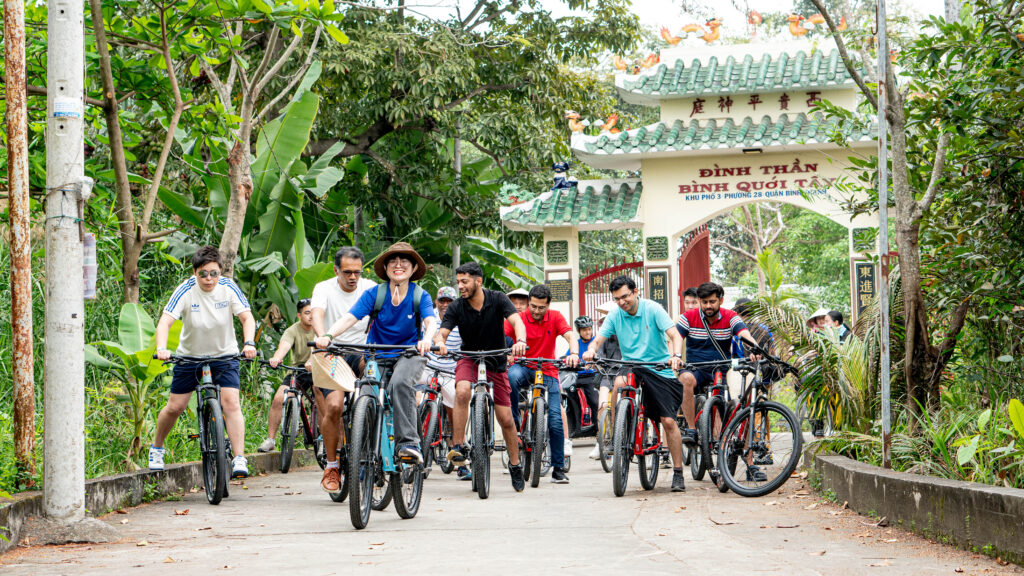
Read more: 25 Unusual Things to Do in Ho Chi Minh City
Immerse yourself in Jackfruit Adventure’s Ho Chi Minh City District Guide.
At Jackfruit Adventure, we organize Ho Chi Minh City Cycling Tour and Team Building Ho Chi Minh. With a deep knowledge of Saigon City and local connections, we believe we can give you an awesome bonding time together. Contact us today if you have any requests or questions about preparing a trip for your team to bond in Ho Chi Minh, Vietnam.
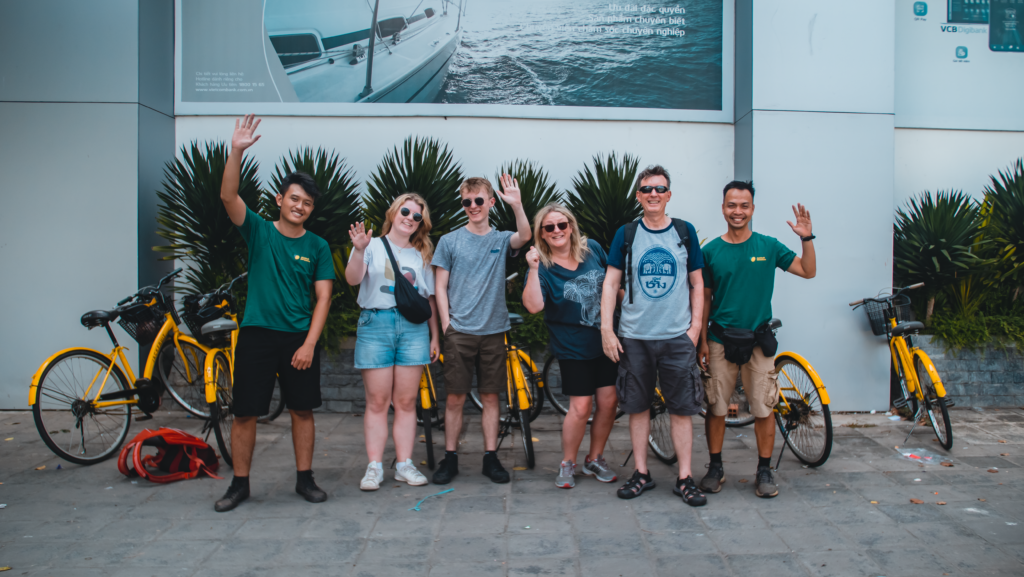
Don’t Miss Out! Your Free 1-Page Guide to Top 20 things to do HCMC at Night
A quick, mobile-friendly guide with local-approved spots and direct links—just tap and go! No fluff, just easy night-time fun. Subscribe to download.





